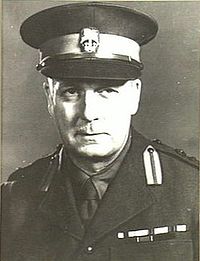- Clive Steele
-
Sir Clive Selwyn Steele 
Brigadier Clive SteeleBorn 30 September 1892
Canterbury, MelbourneDied 5 August 1955 (aged 62)
Heidelberg, MelbourneAllegiance  Australia
AustraliaService/branch Australian Army Years of service 1915–1946 Rank Major General Commands held 14th Battalion
4th Divisional EngineersBattles/wars World War I
World War IIAwards Knight Commander of the Order of the British Empire
Distinguished Service Order
Military Cross
Volunteer Decoration
Mentioned in Despatches (2)
War Cross (Greece)Major General Sir Clive Selwyn Steele KBE, DSO, MC, VD (30 September 1892 – 5 August 1955) was an engineer and a senior officer of the Australian Army who served in both World War I and World War II. He was instrumental in the expansion of the Royal Australian Engineers in preparation for the war against Japan.
Contents
Early life
Born on 30 September 1892 at Canterbury, Melbourne the son of Herbert Selwyn Steele and Alice Lydia née Sinclair, Clive was educated at Scotch College (prefect and captain of boats, 1910), and the University of Melbourne (B.C.E. 1919). He joined the Militia in 1912.[1]
World War I
Appointed as a second lieutenant in the Royal Australian Engineers, Australian Imperial Force on 8 October 1915, he sailed for Egypt in November with the 5th Field Company. Arriving on the Western Front in March 1916, he was promoted to captain in September. While on recreation leave he married Amie Osland Bilson on 6 January 1917 at West Brompton, London. During actions around Péronne, France in August 1918, he commanded a unit undertaking repairs to bridges while under artillery and machine-gun fire. On the 31 August he undertook reconnaissance 200 yards [183 metres] in front of the Australian lines, providing details of the state of bridges across the River Somme and the Somme Canal. For this action he was awarded the Military Cross. He was promoted to major in October. Arriving back in Australia he was discharged on 1 August 1919.[1]
Interwar
Finishing his engineering degree at Melbourne University in 1919, he gained employment with Australian Reinforced Concrete & Engineering Co. until 1921 and then with James Hardie & Co. Pty Ltd from 1921 to 1923. Setting up private practice in 1924 as a consulting engineer, he designed and supervised structural works including the State Savings Bank of Victoria building in Melbourne, the members' stand at Flemington Racecourse, the National Mutual Life Association of Australasia Ltd building in Brisbane, Her Majesty's Theatre, Sydney and the Melbourne Town Hall.[1] From 1919 he had continued to serve in the Militia. In 1926 he was promoted to lieutenant colonel and appointed to command the 4th Divisional Engineers (1926–1931) and the 14th Battalion (1933–1939).
World War II
With the outbreak of World War II he was seconded to the Second Australian Imperial Force on 13 October 1939 as the commander of the 6th Divisional Engineers. He was promoted to temporary brigadier and appointed chief engineer of I Corps in April 1940. He sailed for the Middle East in September and during the Greek campaign in April 1941, he was chief engineer of the Anzac Corps. During the withdrawal at Farsala on 18 April, despite attacks by German aircraft, he organised the filling of a bomb crater in the road which was impeding the withdrawal of the allied forces. He was awarded the Distinguished Service Order and the Greek War Cross, and was twice Mentioned in Despatches for his service in the Middle East.[1]
Transported to Java, Netherlands East Indies in January 1942, he was then sent to Sumatra on 14 February, where he helped organise the evacuation of allied troops from Oosthaven. He returned to Australia in March, and in April was promoted to temporary major general and appointed engineer-in-chief at Land Headquarters, Melbourne.[1]
In preparation for the was against Japan, he established the R.A.E. Training Centre at Kapooka, New South Wales and increased the size of the School of Military Engineering at Liverpool, which trained sappers who disarmed mines, demolished obstacles, provided water supplies and other services to military camps, cut and milled timber, built huts, roads, bridges, railways, airfields and wharves, and operated the army's water-transport vessels. With the reorganization of Land Headquarters in October 1943, fortifications, works, engineer stores and transport were added to Steele's responsibilities. On 12 March 1946 he transferred to the Reserve of Officers.[1]
Later life
Steele had been awarded the W. C. Kernot medal for 1944 by the University of Melbourne. He was active in the Institution of Engineers, Australia and was appointed Knight Commander of the Order of the British Empire (KBE) in 1953.[1]
He died of myocardial infarction on 5 August 1955 at the Repatriation General Hospital, Heidelberg and was cremated. He was survived by his wife; the couple were childless.[1] Steele Barracks, the current home of the School of Military Engineering, is named in Sir Clive Steele's honour.
References
Allen • Beavis • Bennett • Berryman • Blake • Blamey • Boase • Bridgeford • Burston • Callaghan • Cannan • Chapman • Clowes • Downes • Drake-Brockman • Durrant • Eather • Herring • Jess • Lavarack • Locke • Mackay • Milford • Morshead • Morris • Murray • Northcott • Plant • Ramsay • Rankin • Robertson • Rowell • Savige • Simpson • Smart • Stantke • Steele • Steele • Stevens • Sturdee • Vasey • White • Whitelaw • WynterCategories:- 1892 births
- 1955 deaths
- Australian engineers
- Australian generals
- Australian military personnel of World War I
- Australian military personnel of World War II
- Companions of the Distinguished Service Order
- Deaths from myocardial infarction
- Knights Commander of the Order of the British Empire
- Recipients of the Military Cross
- Recipients of the Volunteer Decoration
- Recipients of the War Cross (Greece)
Wikimedia Foundation. 2010.
